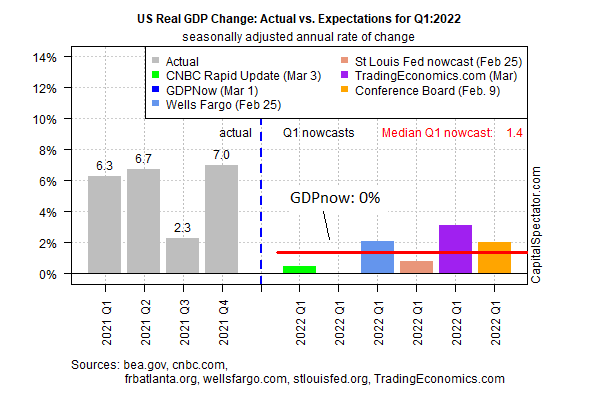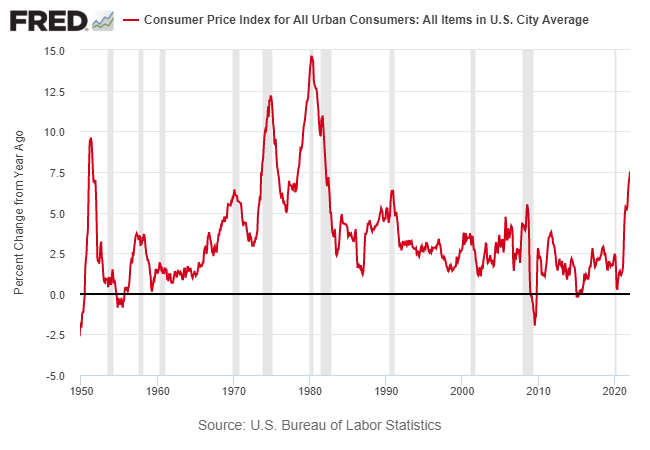As the Ukraine war rages on, the global economy will suffer, and the blowback will spill over to the US to some degree. The repercussions are starting to show up in the first-quarter forecast for first-quarter GDP activity.
The good news is that US economic activity has a decent tailwind going into the uncertainty of war. The bad news, the macro trend was already decelerating well before Russia invaded Ukraine. Q1 growth was all but certain to slow after Q4’s red-hot increase. As the shock of war increasingly squeezes the global economy, the US slowdown will likely be deeper than it would have been having peace in Ukraine prevailed.
Thanks to the war, the main economic threat: accelerating headline inflation as commodity prices – energy in particular – soar. Not surprisingly, we already see significant downgrades in some Q1 nowcasts as this, and other factors begin to show up in the numbers.
US output is expected to increase 1.4% in the first three months of the year (seasonally adjusted annual rate), based on the median estimate for a set of nowcasts compiled by CapitalSpectator.com. That’s a sluggish pace, and it reflects a downgrade from the previous 1.9% estimate published in mid-February.

Some of the latest nowcast revision are even lower. Notably, the Atlanta Fed’s GDPNow model is estimating Q1 activity to be flat, as of March 1.
The spike in energy and commodity prices generally in recent days is the primary threat at the moment. Energy is a key input for headline inflation and so it’s clear that the already elevated level of pricing pressure will increase further in the near term. That outlook raises recession risk, perhaps substantially for the near term.
Students of economic history will note that inflation spikes are often linked with recessions. The chart below demonstrates this history via the annual change in the consumer price index, which has a habit of rising sharply either during of just ahead of recessions (shown by vertical grey bars). Every business cycle is different and there’s no macro law that predetermines that a sharp rise in inflation must lead to recession. But the inflation-related threat has surely increased significantly since Russia invaded Ukraine, which in turn unleashed sanctions from the West and a surge in energy prices.
As Fitch Ratings noted earlier this week:
“Inflation challenges could start to threaten the global economic outlook this year.”

Meanwhile, US economic activity reflects an upbeat profile, largely due to pre-war data. For example, the Philly Fed ADS Index – a real-time measure of current business conditions – shows a solid pace of growth through Feb. 25. The New York Fed’s Weekly Economic Index indicates a similarly upbeat profile, based on data through Feb. 26.
But these are early days, and the true test is yet to come. Short of peace breaking out tomorrow and a return to something approximating “normal” conditions for global geopolitical risk, the economy’s set to endure a rough ride for the foreseeable future.
At the moment, there’s still a case for modest optimism that the US will avoid a recession. Rather, the pressing question is how much of a slowdown are we looking at for the near term? The haircut will surely be substantial relative to Q4’s blowout gain. Deciding if there’s something worse than a sharp deceleration in growth brewing depends primarily on how the war evolves in the days and weeks ahead.
Even if the worst fears are realized, the economic bounce-back will likely be potent. Unfortunately, estimating the timing of that positive-shock event is uncertain in the extreme while the war continues.
